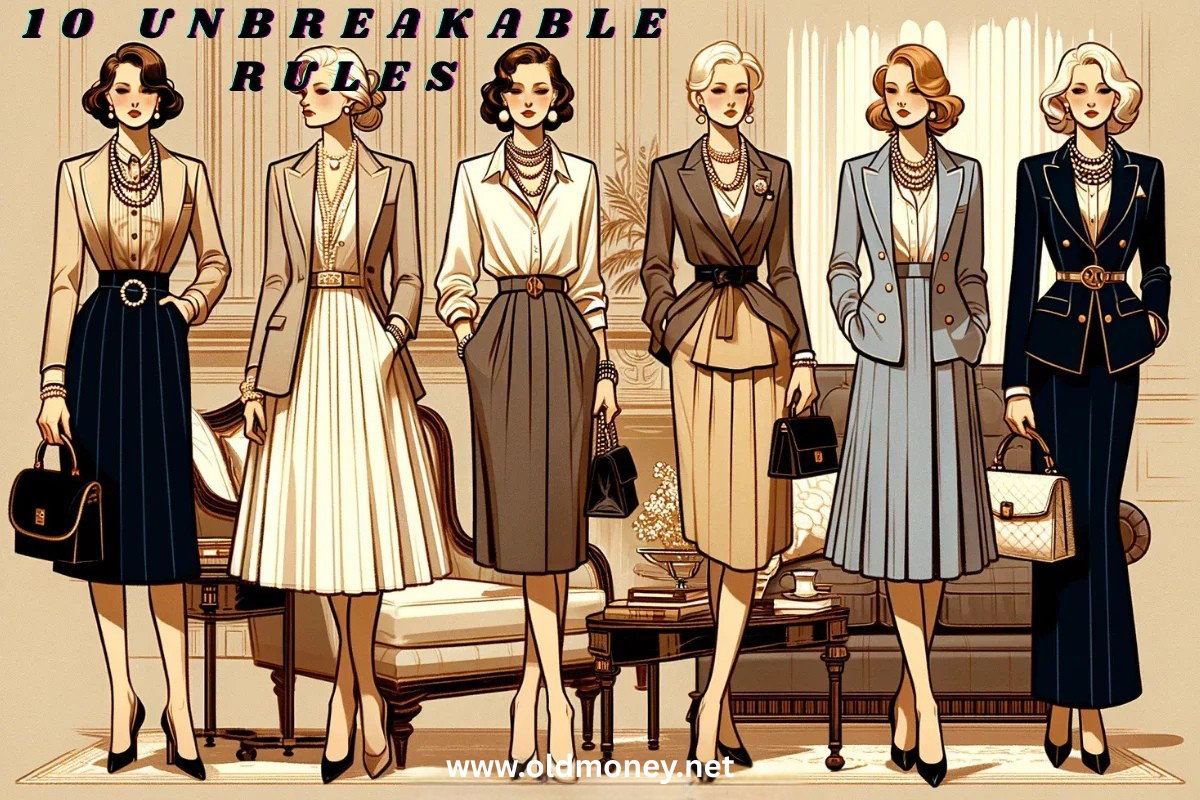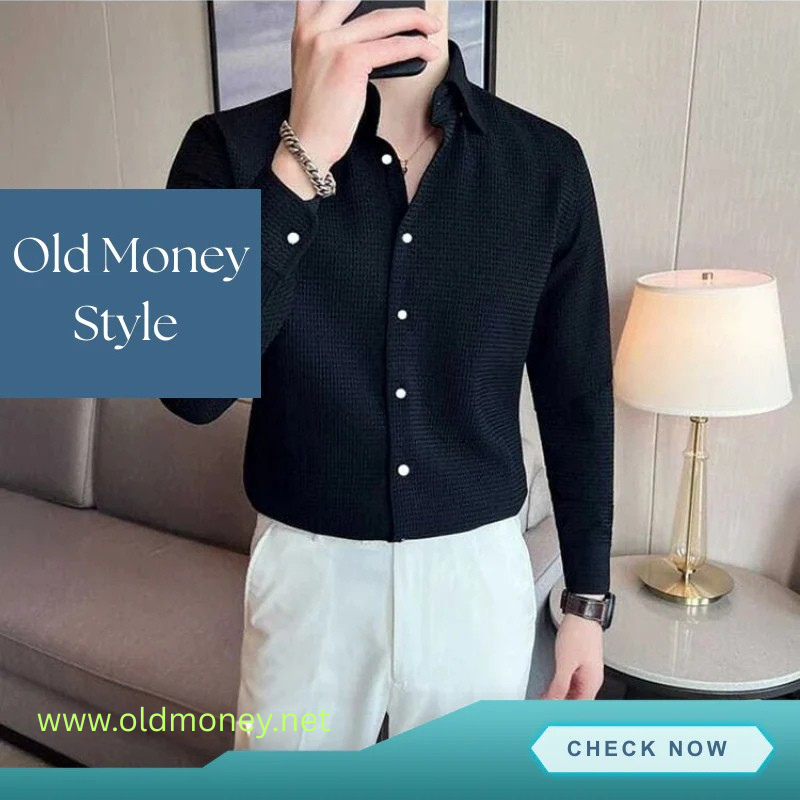
10 Fashion Rules Old Money Women Follow Without Question
Old money women follow a handful of fashion rules without question. The list below explains those rules, why they work, and how you can apply them without copying anyone’s surname or social circle.
1. Buy fewer pieces, buy better fabric
Quality is the first filter. Long-staple cotton, fine worsted wool, silk twill, linen with proper weave density, and real cashmere survive years of wear. One shirt that holds its shape after 40 washes beats five that sag after two. Before you click “add to cart,” ask: Will this fabric pill, fade, or lose structure quickly?
Practical move: build your core with shirts that already meet those standards. See how a well-cut Oxford or poplin anchors dozens of outfits in the Old Money Shirts collection.
2. Fit is non-negotiable
Nothing enters the closet unless the shoulder seam sits where it should and the trouser hem kisses, not puddles on, the shoe. Tailors are not an optional luxury; they are part of the purchase price. A micro tweak (half an inch off a sleeve, a gentle waist nip) turns decent into heirloom.
Rule of thumb: try on garments with the shoes and under layers you plan to wear. Photograph front, side, and back. If something looks “almost right,” schedule a fitting, not a return.
3. Logos stay quiet (or invisible)
Old money wardrobes rely on construction and materials to speak. A visible logo risks looking like you are trying to prove something. Texture, drape, and stitching are the “branding.” If a label is obvious, it is usually on the inside.
Tip: when you review a piece, cover any logo with your hand. If it still looks refined, keep it. If not, move on.
4. Neutrals form the spine, accents do the talking
Navy, charcoal, cream, camel, chocolate, black, and white make mixing effortless. Accent colors arrive through a scarf, a lipstick shade, a silk blouse, a ribbon on a hat. Limiting the palette reduces shopping mistakes and increases outfit mileage.
Create a two-row color chart for yourself: row one is core neutrals, row two is 3 to 4 accents that flatter your skin tone. Shop within that matrix.
5. Shoes are maintained like assets
Leather is conditioned, soles are replaced before holes appear, heels re-capped on schedule. Rotation is standard: at least 24 hours between wears for leather pairs, with cedar trees inserted immediately after use. If a pair scuffs, it is polished, not retired.
Browse dependable silhouettes and learn how construction choices affect longevity by studying options inside the Old Money Shoes editions.
6. Care rituals happen off-camera
Garments are brushed, steamed, and stored correctly. Knitwear rests flat or on padded hangers. Suits breathe in cloth bags, not plastic. Summer fabrics get washed in cool water and dried away from sunlight. These routines take minutes but add years.
Set a monthly care calendar: week 1 shoes, week 2 knitwear, week 3 tailoring, week 4 jewelry check. Maintenance becomes a habit, not a scramble.
7. Jewelry is understated and often inherited
Pearl studs, a slim gold bangle, a signet ring with initials, a fine chain with a locket. Pieces carry stories and are chosen for permanence, not trend value. If an item flashes before it speaks, it is usually skipped.
Ask yourself: Will I wear this at 30, 50, and 80? If yes, it is worth consideration. If not, save your budget.
8. Trends are sampled, not swallowed
A single seasonal detail might enter the wardrobe if it aligns with existing shapes and the quality bar. Otherwise, noise is ignored. A sleeve detail here, a fabric finish there. The core silhouette does not swing wildly with TikTok.
Practical test: imagine the piece in two years. Still elegant? Good. Looks like a fad relic? Pass.
9. Repair precedes replacement
Buttons are reinforced, seams restitched, knits darned. A trusted cobbler and tailor are long-term relationships. Reweaving, re-lining, re-soling, and re-dyeing are normal. Throwing away a garment for a loose hem is wasteful and out of character.
Keep a small repair kit at home and a repair budget line in your spreadsheet. When something breaks, fix it within a week so it does not languish.
10. Wardrobe plans around real life, not photos
Old money dress codes evolved around board meetings, school runs, charity luncheons, travel, and weekends on actual grass, not just camera lenses. Every purchase has a job, and outfits are planned for function. When they need something new, they review what is already there, then fill the gap.
If you need sharper trousers, study cut, rise, and drape options in the Old Money Pants range to see what silhouette bridges your existing shoes and shirts.
Why these rules still work
Three outcomes explain the loyalty to these habits:
-
Cost per wear collapses. A blazer that lasts a decade is cheap by year five.
-
Environmental burden drops. Global research shows textile waste is driven by short wear cycles and overproduction. The Ellen MacArthur Foundation quantifies this “garbage truck every second” problem and outlines circular strategies that start with buying less and using longer.
-
Perceived polish rises. Consistency and care signal confidence better than trend-chasing. The United Nations Environment Programmed highlights that fashion’s carbon and water impact hinge on production volumes and disposal practices, not only on fiber swaps (https://www.unep.org/news-and-stories/story/putting-brakes-fast-fashion).
Applying the mindset: a quick operational guide
Step 1: Audit twice a year. Lay everything out. Track what you actually wore 10+ times. Remove duplicates. Flag gaps.
Step 2: Build a core list. Shirts, trousers, skirts, dresses, outerwear, shoes, accessories. One or two perfect options in each slot beat five mediocre ones.
Step 3: Budget for tailoring and repairs. Add 10 percent of your annual clothing spend for maintenance.
Step 4: Track wears. Use a simple note on your phone or a wardrobe app. When something hits 40 wears and still looks good, celebrate that purchase.
Step 5: Learn basic care. Hand washing silk, brushing wool, conditioning leather. If you can do oil changes on clothes, you extend life drastically.
Step 6: Reduce impulse windows. Wait 24 hours before buying. If the urge fades, you saved money. If it remains, evaluate quality and fit again.
Step 7: Source ethically where possible. Verify material transparency, but remember: the biggest sustainability win is buying less and keeping it longer.
Step 8: Set a neutral capsule. If everything mixes, you reduce “nothing to wear” mornings. Neutrals also hide wear better.
Step 9: Add personality with accessories. Scarves, belts, small jewelry, silk squares change the tone without buying full outfits.
Step 10: Document your style rules. Write a one-page personal style charter. It becomes your filter against random trends.
Frequently overlooked details that matter
-
Seam allowances: Thicker allowances allow future adjustments. Cheap garments cut this to save fabric.
-
Button quality: Mother-of-pearl or horn outlast plastic. Loose buttons on arrival signal poor QC.
-
Lining fabric: Bemberg or silk breathes and slides well. Polyester linings trap heat.
-
Heel counters and shanks: Shoes with proper internal structure hold shape and support arches.
-
Pressing and blocking: Tailored pieces need regular pressing to reset fibers. Sweaters benefit from re-blocking after wash.
-
Storage climate: Avoid hot, humid environments. Cedar and silica gel packs help.
-
Documentation: Keep receipts and care tags. They help with insurance, resale, and correct cleaning.
Mini case study: building a seasonless capsule
Assume you start with:
-
3 shirts (white Oxford, blue poplin, cream silk)
-
2 trousers (charcoal wool, cream cotton)
-
1 blazer (navy hopsack)
-
2 pairs of shoes (brown loafers, black pumps)
-
1 dress (black sheath)
-
1 coat (camel wrap)
-
Accessories (pearl studs, slim gold bracelet, silk scarf)
From these 10 pieces, you can build dozens of combinations with minimal change. Add one accent blouse, one patterned scarf, and a statement belt to double the outfit count. The rule holds: small additions, big flexibility.
How to evaluate a new purchase quickly
Use the “5P” filter:
-
Purpose: What problem does this solve?
-
Proportion: Does it balance with your existing silhouettes?
-
Palette: Does it live inside your neutral/accent chart?
-
Performance: Will the fabric and construction survive your lifestyle?
-
Plan: Do you already know 3 outfits it works in?
If any answer is fuzzy, pause.
When exceptions make sense
Yes, there are moments to break rules: a gala requiring a vivid gown, a statement hat for a specific event, a trend item that aligns with your brand. The key is intention. Exceptions are planned, not impulse-driven. The next morning, the closet returns to its steady state.
Final takeaway
Old money women follow these rules because they work. They protect budgets, the planet, and personal polish. You do not need legacy wealth to adopt them. Start with one category at a time: upgrade shirts, refine trouser fits, invest in shoe care. Build habits around maintenance and editing. Over a year, your wardrobe will feel lighter, look better, and last longer.
Choose quality, fit, and care. Say no to noise. Your future self will thank you.



